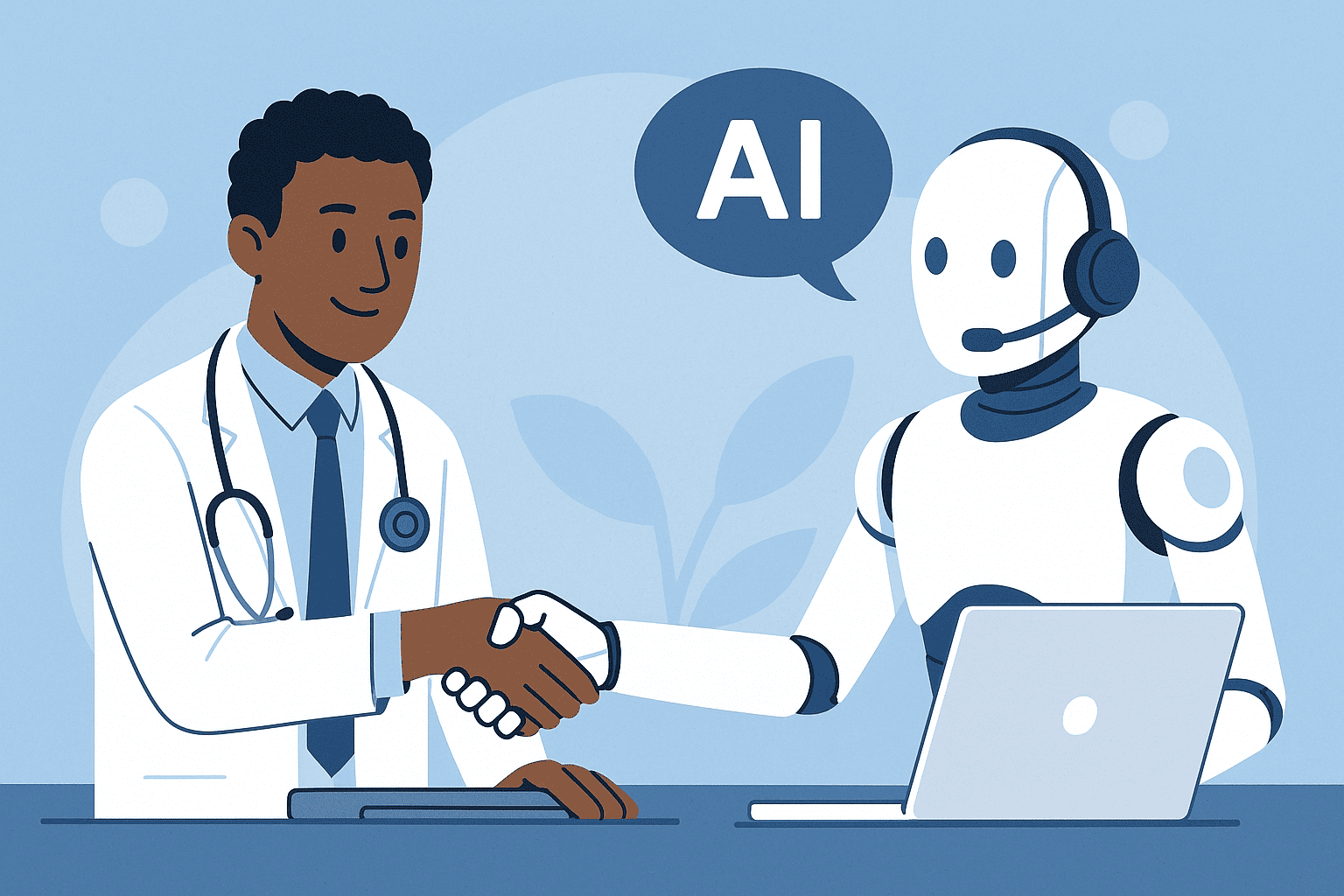Updated on: July 10, 2025
The rise of Artificial Intelligence (AI) in healthcare is no longer just a distant vision—it’s happening right now. From AI diagnostics to predictive analytics, technology is rapidly transforming how care is delivered. But the most impactful changes often occur in the background: the way we document, manage, and access patient information.
This is where Human AI Collaboration shines, especially in the realm of clinical documentation with tools like Virtual Medical Scribes powered by AI.
In this article, we’ll explore:
- What Human AI Collaboration means in healthcare
- The role of AI medical scribes in easing documentation burdens
- Why pairing humans with AI leads to better patient care
- How DocScrib makes this transformation seamless
👉 Learn more about how DocScrib supports smarter, faster documentation
What is Human AI Collaboration?
At its core, Human AI Collaboration refers to a working partnership where artificial intelligence enhances human decision-making and efficiency—rather than replacing it.
In healthcare, this means:
-
AI handles repetitive, time-consuming tasks (like documentation)
-
Humans focus on critical thinking, empathy, and patient connection
This synergy ensures that technology works for the clinician, not the other way around.
The Documentation Dilemma: Why Human AI Collaboration Matters
Clinical documentation is a necessary but time-consuming and burnout-inducing part of healthcare. Physicians today spend nearly 50% of their workday on EHR tasks—often outside of patient hours.
The solution isn’t choosing between humans or AI—it’s combining both to:
-
Reduce administrative load
-
Improve note accuracy
-
Free up time for direct patient care
This is where Virtual Medical Scribes and AI-driven transcription tools like DocScrib play a crucial role.
How Human AI Collaboration Works with AI Medical Scribes
Imagine this:
👩⚕️ You walk into a patient room. You focus entirely on the patient—no typing, no note-taking.
🤖 Meanwhile, DocScrib’s AI-powered medical scribe listens, transcribes, and generates structured clinical notes automatically.
👨⚕️ You quickly review and approve the draft—ready for the EHR.
This is Human AI Collaboration in action.
The AI:
-
Handles the heavy lifting of note creation (SOAP notes, HPI, assessments)
-
Learns and adapts to your speaking style and specialty
-
Integrates directly with your Epic, Cerner, or other EHR system
You:
-
Make medical decisions
-
Add human context and nuance
-
Focus on the human side of healthcare
👉 See how Docscrib’s AI medical scribe solution enhances your workflow: https://docscrib.com/
Key Benefits of Human AI Collaboration in Healthcare Documentation
1. Time Savings
AI scribes can save clinicians up to 2 hours daily, reducing late-night charting and after-hours work.
2. Improved Accuracy
AI minimizes missed details and ensures standardized note formatting.
3. Reduced Burnout
By offloading repetitive tasks, AI lets clinicians spend more time on meaningful patient interactions.
4. Cost-Effective
Compared to hiring full-time human scribes, Virtual Medical Scribes powered by AI offer scalable, affordable solutions.
5. Better Patient Care
When clinicians aren’t buried in documentation, patient engagement and satisfaction improve.
Why AI Alone Isn’t Enough: The Human Element
AI tools are powerful, but they aren’t perfect. Human oversight remains essential for:
-
Clinical judgment
-
Ethical decision-making
-
Contextual understanding
In the case of AI medical scribes, clinicians still review, edit, and approve notes—ensuring accuracy and compliance.
This collaborative model enhances the best of both worlds:
✅ AI efficiency
✅ Human insight
👉 Want to see the power of Human AI Collaboration for yourself? Schedule a Free Demo
Real-World Impact: Human AI Collaboration with DocScrib
Dr. Mehta, Family Medicine
“Since adopting Docscrib’s AI scribe, I finish my notes during clinic hours—no more late nights. The AI is accurate, and I have the final say. It’s the perfect balance of technology and human touch.”
Stories like these showcase how Human AI Collaboration is already transforming healthcare practices of all sizes.
How to Train Your Team for Human AI Collaboration Success
To ensure smooth adoption:
-
Educate: Highlight benefits and how AI complements—not replaces—the clinician’s role.
-
Demonstrate: Live demos help showcase real-time note generation.
-
Provide Ongoing Support: Keep communication open for feedback and adjustments.
👉 Docscrib offers full onboarding and training support for seamless integration into any clinical workflow. Contact us to learn more
The Future of Human AI Collaboration in Healthcare
The healthcare industry is moving toward a hybrid model where:
-
AI handles documentation, analysis, and repetitive tasks.
-
Humans focus on complex care, empathy, and patient connection.
This future is not far off—it’s already happening in practices adopting AI medical scribes like DocScrib.
Key Takeaways
✅ Human AI Collaboration in healthcare enhances efficiency, accuracy, and clinician satisfaction.
✅ AI scribes like DocScrib streamline SOAP notes and EHR workflows.
✅ The combination of human insight and AI technology leads to better patient care.
👉 Ready to experience Human AI Collaboration with Docscrib?
📅 Book Your Free Demo
Or visit DocScrib.com to get started.
Frequently Asked Questions (FAQ)
1. What is Human AI Collaboration?
It’s the partnership between AI technology and human professionals to improve efficiency, accuracy, and outcomes—especially in healthcare documentation.
2. Can AI replace medical scribes completely?
No. AI works best alongside humans to handle repetitive tasks, while humans provide judgment, empathy, and oversight.
3. Is Docscrib’s AI secure?
Yes. Docscrib is fully HIPAA-compliant, with enterprise-grade security for all patient data.
